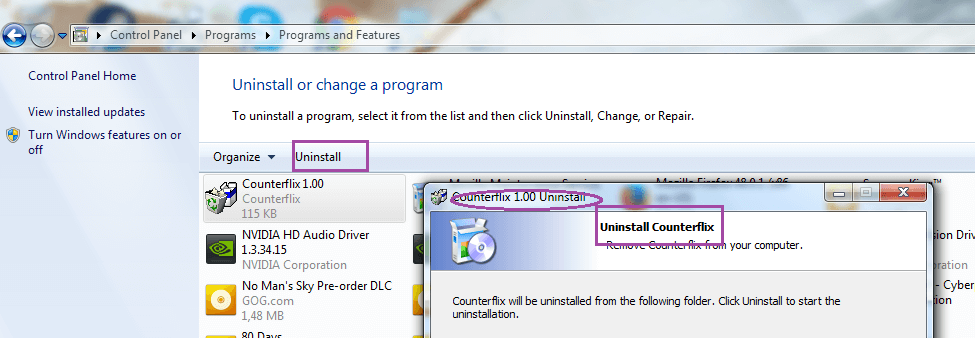This page aims to help you remove ads by Counterflix. These Counterflix removal instructions work for Chrome, Firefox and Internet Explorer, as well as every version of Windows.
Having problems with pop-up ads appearing in your Chrome or Firefox browser and being generated by Counterflix? There is a specific category of online advertising tools, which are specially developed to display different types of promotional messages. They come in the forms of banners, pop-ups, links, boxes, blinking messages, notifications, and web pages and appear on the users’ screen every time they open their browser. This category is known as adware. If you are experiencing a flow of undesired and intrusive ads as the ones described above, then most probably you are having an adware application that is operating on your system. In this article, we are going to explain the specifics of one particular program of this type, which is the probable source of your disturbance. The program is called Counterflix and in this guide, you are going to learn how to effectively remove it, in case you wish to save yourself from the ads. A few more words about how exactly it operates would give you a better understanding, so we suggest you read the description before you proceed to the removal instructions.

Software + advertisement = Adware
The idea of creating a special piece of software that can display different advertisements originates from the online marketing industry. Recently, online advertising has turned so big, that it needs some special tools to display its numerous ads. That’s why the advertisers and the software developers have shaken their hands and have created adware. This is an application that is specially developed to display ads whenever users open their browser. Even though the end users may not be really happy by the rather aggressive than helpful nature of the ads-generating software, there is a deal for both the advertisers and the developers. The marketers get good exposure of their ads, while the developers earn from the clicks on the ads through a method called Pay-Per-Click. The goal is simple – to display as many ads as possible and get as many clicks as possible.
To do that, the developers often distribute adware with their software installation packages and bundle it with free applications. Sometimes, spam emails may contain invitations for testing new software or trying free apps, which are “sponsored” through adware that gets along with them. A torrent, open source platforms, direct downloads and download managers may also include such ads-generating applications inside their package. However, while there is nothing wrong with this practice of program bundles, users may not really be aware when they are installing adware. This happens when they run the installation package of the program they want and quickly proceed with the standard installation process instead of checking the advanced options in the bundle. Usually, this is where they can find the adware and manually deselect it from the installation in case they don’t want it to get installed on their system.
Counterflix “Virus”?
Many people would wrongly refer to Counterflix as a virus. When in fact Counterflix is not a virus, legally speaking. Apart from flooding you with annoying ads, Counterflix may perform a few additional activities, which users may find disturbing. While on your system, Counterflix may keep a record of the websites you visit, how often you visit them, what you search for on the web, when you log in to your social accounts, what content you like there, what you share, your browsing history and bookmarks, etc. This information, known as traffic data, is usually collected and transmitted to the developers, who may analyze it and build your personal profile based on that. This way, they may optimize the ads that you see according to your interests and latest searches to improve the chances of you clicking on them or sell this data to other marketers as valuable marketing information. This practice of tracking the user’s Internet surfing habits may be considered as an invasion of their privacy, especially if this data lands in the hands of unknown third parties.
Another activity that causes serious irritation is when banners, pop-ups, boxes and pages start to appear in dozens and closing them becomes an impossible task. Closing one ad may lead to opening a few others and these series may continue until the screen freezes or the computer bugs. In such a huge flow of ads, it is not excluded that you may click on a misleading link or a message that could expose you to some online risks like different types of viruses, Trojans or even Ransomware. Although these risks really exist, it doesn’t mean that Counterflix is a malicious application or a virus. In general, adware is not capable of harming your system and won’t be detected by any antivirus as a threat, because it does not contain malicious scripts. Unlike Ransomware or Trojans, Counterflix is considered a harmless application, which at its best could only bring you some browsing-related disturbance. If you don’t want to tolerate it, however, the removal guide will help you deal with this program in no time. Just make sure you follow the instructions closely and let us know in case you need any help.
SUMMARY:
Counterflix “Virus” Removal
You are dealing with a malware infection that can restore itself unless you remove its core files. We are sending you to another page with a removal guide that gets regularly updated. It covers in-depth instructions on how to:
1. Locate and scan malicious processes in your task manager.
2. Identify in your Control panel any programs installed with the malware, and how to remove them. Search Marquis is a high-profile hijacker that gets installed with a lot of malware.
3. How to clean up and reset your browser to its original settings without the malware returning.
You can find the removal guide here.
For mobile devices refer to these guides instead: Android , iPhone

Leave a Reply